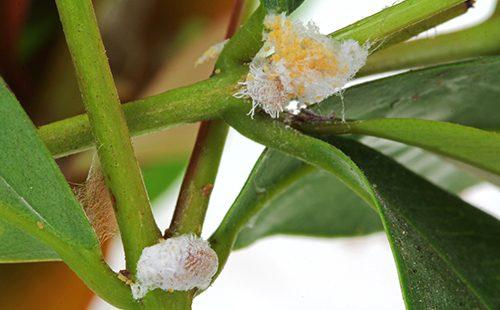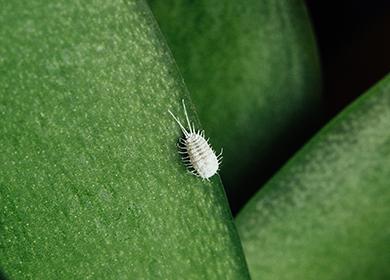The content of the article
In advanced cases, the plant is completely covered with a dirty white coating, reminiscent of cotton wool. At this stage, it remains only to throw it away with the pot. The sooner a pest can be detected, the higher the chances of saving a “green friend”.
General information about the parasite
The mealybug looks peculiar - it is a small insect from 1 to 5 mm in length. The body of the pest is covered with a powdery whitish coating, bristles are visible on the sides. Transverse stripes stand out on the back. In different species, the color varies from white and cream to pinkish.
Males and females differ in structure. The males have developed paws, wings, the abdomen and head stand out, the mouth organs are reduced - adult males do without food. The body of a female without pronounced departments resembles a larva. Waxy plaque partially protects pests from chemicals, which complicates the fight.
Female worms lay their eggs in a white facial bag resembling a lump of cotton wool. The pest is highly fertile - up to four generations per year. At first, the larvae actively move, for which they were nicknamed vagabonds. Later, they stick to the plant, develop, molt, again become temporarily mobile. Adult females move only in search of a place for laying eggs.
4 dangerous species
In nature, there are more than 1.5 thousand varieties of worms. Most of them live in rainforests. Four species of insects are dangerous for indoor plants.
- Seaside. Oval insects up to 4 mm in length, gray with a pink tint. Males are smaller than females, they fly. Larvae are small, yellow, without a waxy coating.
- Bristly. The color of the insect is from pink to orange, the length does not exceed 3.5 mm. Refers to live-bearing species. Females are motile, colonize on the underside of leaves and young shoots.
- Grape. The body shape is oval, wider than the seaside worm. Coloring is pinkish or yellowish.
- Citrus. Color from white to brownish. Males know how to fly, females live on the same plant throughout their life, secrete a sticky secret.
Signs of Pest
The harm of the mealybug for indoor flowers consists in drawing out the juices. The flower weakens, dies, a sooty fungus settles on the sticky secretions of insects. The pest can be detected by the following signs.
- Stunt growth. The flower stops growing, the buds do not bloom, dry and fall off.
- Discoloration and leaf fall. Foliage stains, turns yellow, falls off.
- Deformation. Young shoots bend, holes appear on the leaves.
Reasons for the appearance
The reasons for the appearance of mealybug on indoor plants are reduced to improper conditions of detention, defective care of flowers. Insects breed actively in moist soil, with high humidity and low air temperature. Favorable conditions create the remains of fallen leaves in pots, the use of tea leaves and other organic residues as fertilizer. The worm penetrates into the apartment:
- with wind through open windows;
- with contaminated soil and pots;
- with new plants.
How to deal with mealybug on indoor plants
The fight against the mealybug should be comprehensive. Experienced growers recommend combining chemical and folk remedies in order to quickly destroy pests. Before processing with any drugs, the plant is wiped or bathed in the shower - water flushes the protective coating on the body of the insect, making it more vulnerable.
Chemicals
With a profuse lesion, it is recommended to immediately treat the plants from the mealybug with chemical preparations. They are presented in stores in a wide assortment - they differ in the active substance, the degree of toxicity.
Means for mealybug are selected individually, taking into account the degree of damage and the type of plant. Judging by the reviews, the most effective insecticides are "Aktara", "Fufanon", "Biotlin", "Confidor", "Actellik", "Fitoverm", "Calypso", "Mospilan". Some growers use Dichlorvos, but it is not designed for flower processing. Processing with any drug is carried out in four stages.
- Inspection. Inspect all parts of the plant, cut heavily affected leaves and branches.
- Cleansing. Wet a cotton pad in a soap solution, mechanically clean the flower from pests.
- Washing. Wash off the remaining soap with clean water, dry the leaves.
- Treatment. The drug is diluted according to the instructions, sprayed on the plant or watered the soil. The treatment is repeated after a few days.
Folk remedies
Quite effective tools are prepared at home based on green soap, garlic, alcohol. They help get rid of the mealybug only in the early stages - in complex cases, plants are immediately treated with insecticides. The most common are five recipes.
- Garlic. Grind 50 g of garlic, pour a liter of boiling water, insist for an hour. Filter, spray the plants.
- Lemon zest. Remove the zest from one lemon, pour a liter of boiling water. Insist about an hour to cool completely, spray flowers.
- Tincture calendula. Lubricate the affected parts of the plant with undiluted alcohol infusion of calendula. The flower is placed in a shaded place. The procedure is repeated for three days in a row.
- Soap with alcohol. 15 ml of green soap and 10 ml of alcohol are added to a liter of water. Mix, process the places of accumulation of insects.
- Butter. In a liter of water add a tablespoon of oil, shake, spray the plants. The treatment is repeated for three consecutive days.

Preventative measures
Proper plant care minimizes the likelihood of pests. When growing indoor flowers adhere to five rules.
- Regular inspection. Every few days, carefully inspect the plants.Particular attention is paid to hard-to-reach places - the underside, leaf axils, root zone, unopened buds.
- Pruning. Timely dried leaves, plant residues from the pot are removed.
- Water treatments. Small plants are bathed periodically in the shower. In large specimens, the leaves and stems are wiped with a damp cloth.
- Watering mode. They keep the soil moist, but do not allow waterlogging.
- Quarantine. Newly acquired plants are quarantined - set separately, prophylactically treated with a weak solution of insecticide and fungicide.
If during the next examination at least one insect was found, treatment is immediately started. In the early stages, you can use home remedies, with a massive lesion - chemical.
Mealybug on indoor plants is a fairly common problem. The pest affects most crops, often leading to their death. The healthier, stronger the plant, the faster it recovers after an insect attack. To strengthen the immunity of plants, fertilizers are regularly applied.
Reviews: “You can still wash the leaves with water with the addition of vodka”
I bought a saxifrage in a flower shop and only at home noticed that the leaves on the inside and the stems were covered with a mealybug. In the presence was only Aktara, and I processed the plant for her. True, I am making a stronger solution (according to the advice of experienced gardeners), it does not adversely affect the plant, but withwhitefly It does an excellent job. Destroyed and worms, they fell like apples in the windy weather Aktara low toxicity for people, and acts on parasites through the gastrointestinal tract. I noticed that more often pests start if the plants are very crowded.
Natalia Marynyak, http://attuale.ru/muchnistyj-chervets-kak-borotsya-na-komnatnyh-rasteniyah/#i-3
Here I once "got" so. I bought an orchid at the discount store and brought it home. And a few days later I discovered this white muck, and not only on purchased, but also on home flowers. It helps well from the worm “Atkara”, sprayed for two weeks, saved its own, the store still disappeared. You can still wash the leaves with water and vodka, and collect this dirty stuff by hand. Worms are hiding, though well, in curls of leaves.
Zhenya, http://parazitam-stop.com/rasteniya/vrediteli/muchnistyj-chervets.html#h2_4
Used oil spraying. It seems to have helped ... But another thing was remembered much brighter: one hundred-plus pots of plants whose leaves are OILED. Almost not laundered !!! Aktara, Actelik are excellent help. Spray, spill the soil - and tie in a trash bag at night, in the morning not a single living worm;)
Maria, https://www.botanichka.ru/article/mealybug/
Gave a fat girl. There are 6 small stalks of 10-15 cm each in a pot. A week later, on the windowsill under the flower, fluffs began to appear, which when rubbed were brick-colored, turned out to be a mealybug. I used a 3-fold treatment with green soap, but after 2-3 days I found these bastards on the plant again. The next was a fitover ... the effect was enough for a week. I removed it manually, sat for an hour and poked with a toothpick every day until I saw that they were crawling out of the ground! Shook out of the pot, and there at the base they have a whole settlement. Cut off nafig roots and a little stalk, washed the cuttings well and in the clean ground for rooting. Now, after 1.5 months, the plant has an increase of 2 cm, it starts up lateral shoots, the plant is completely healthy.
Katya, http://sad-doma.net/bolezni-i-parazity/parazity/muchnistyj-chervets.html

